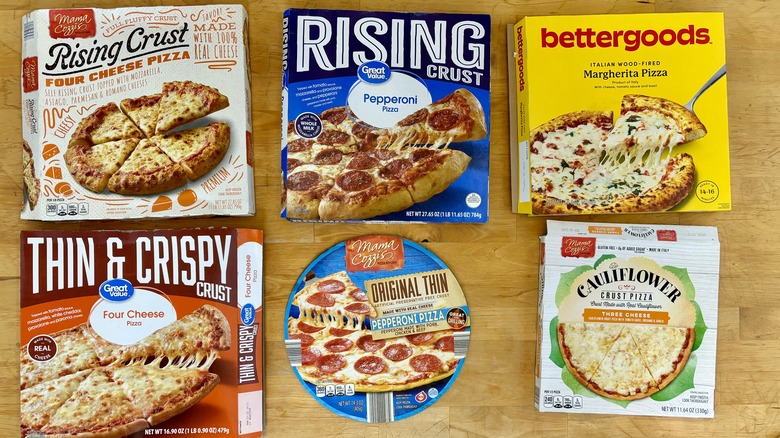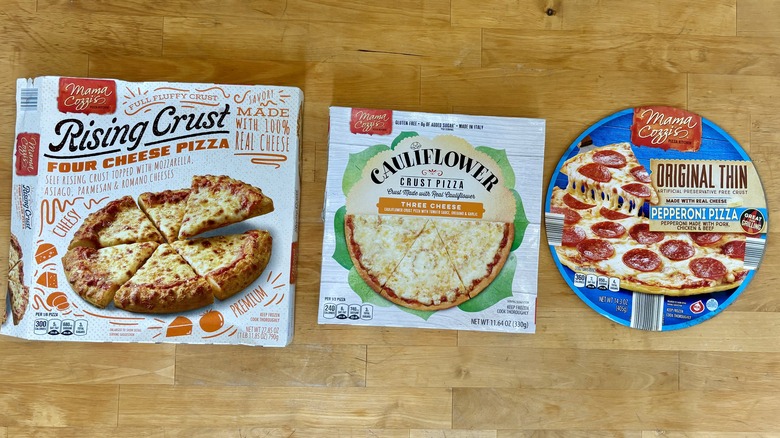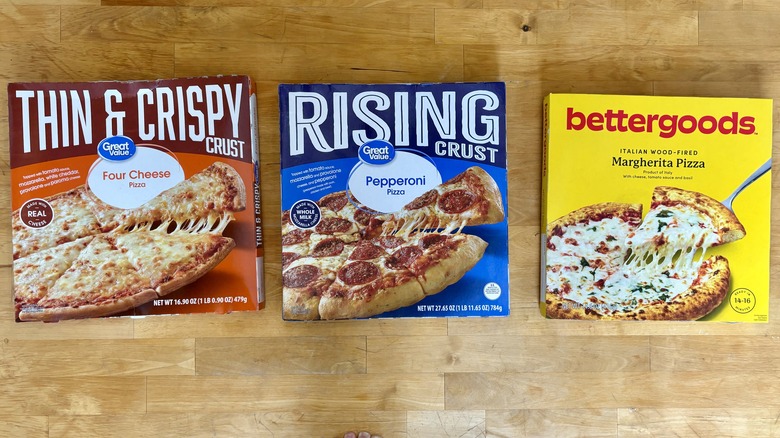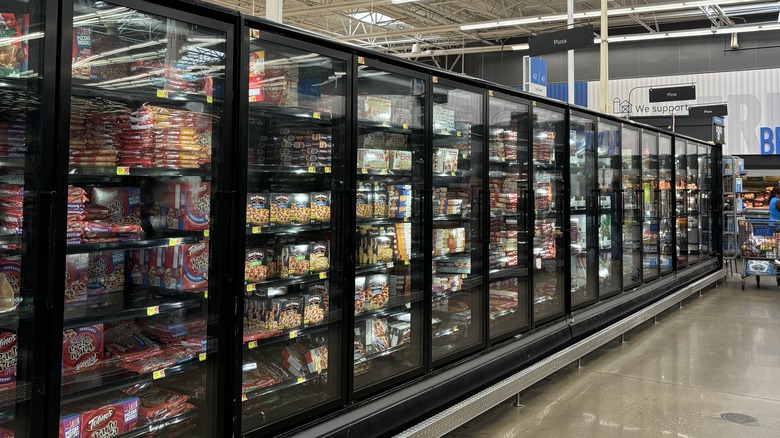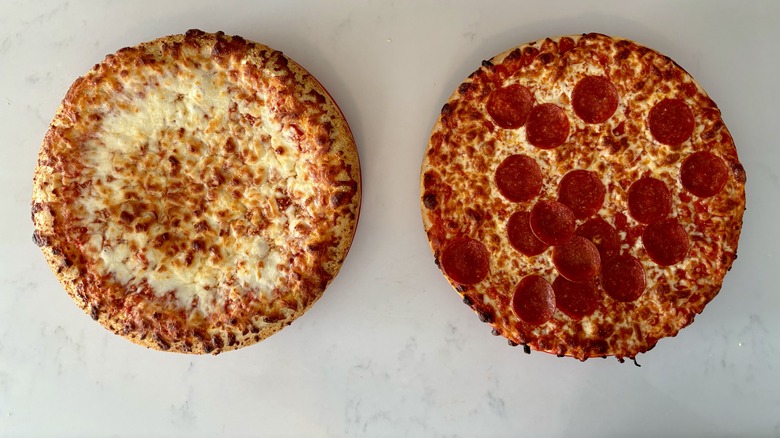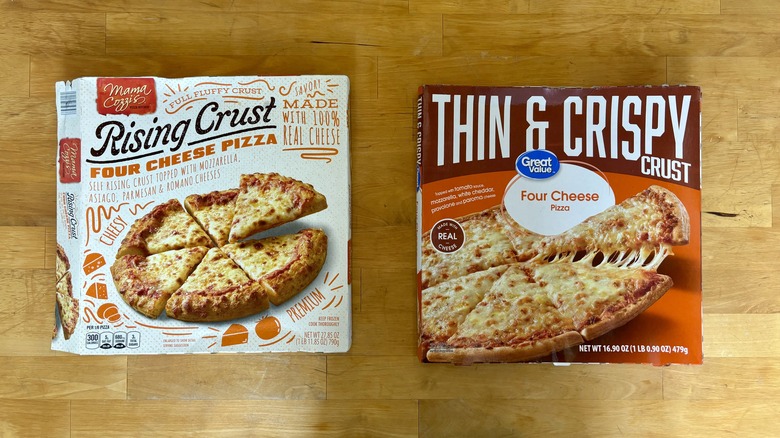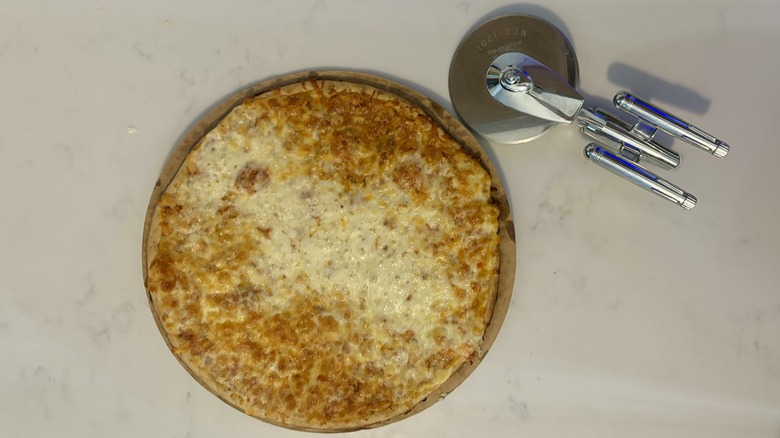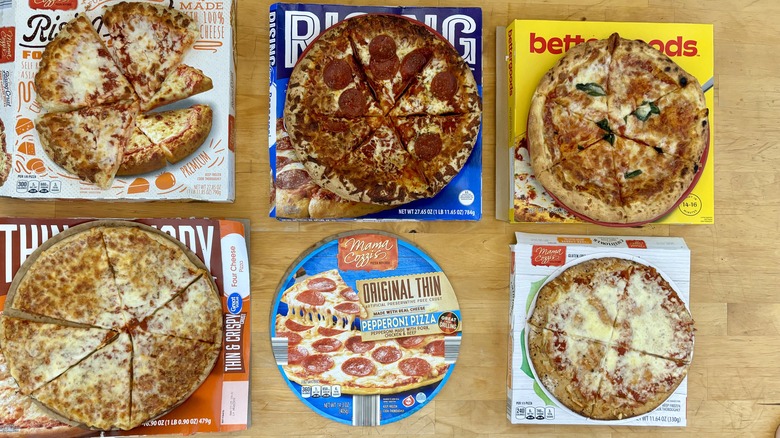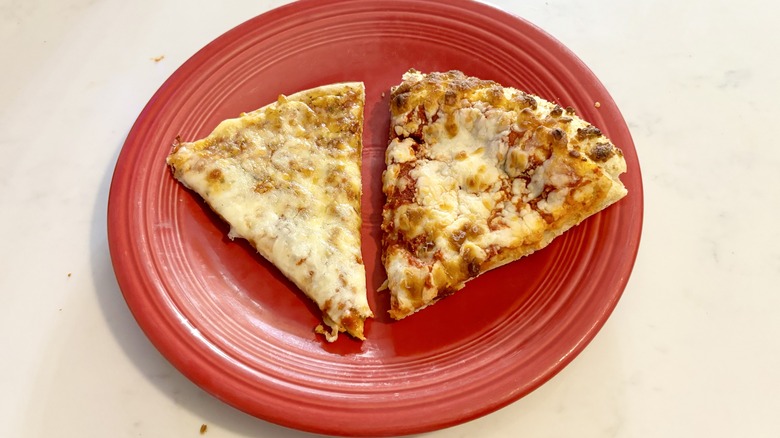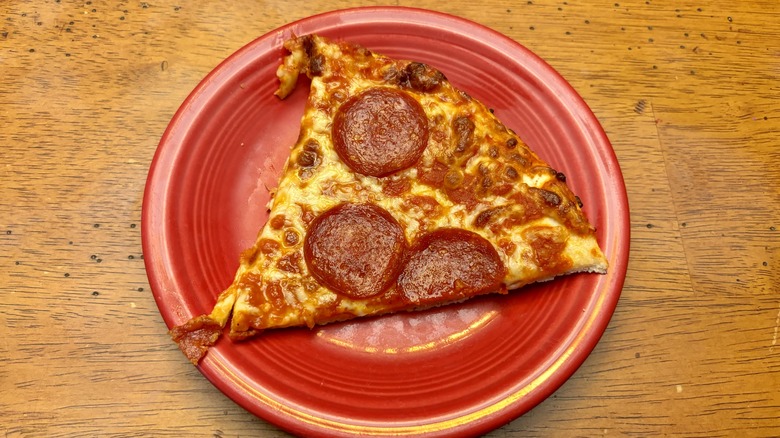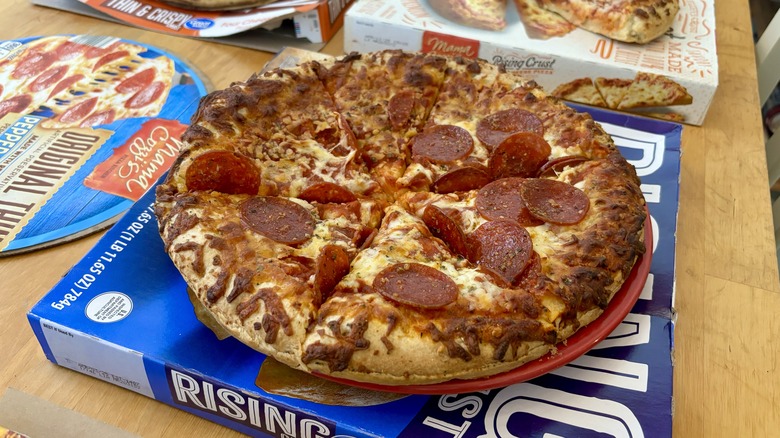Aldi Vs Walmart Frozen Pizzas: The Winner Is Clear
Sometimes, you just want a frozen pizza to get dinner on the table fast. Not all frozen pizza is the same, though. When it comes to budget brands, Aldi and Walmart are two of the top contenders, so I put them to the test: a taste test. I tried a few frozen pizzas from Walmart and Aldi and put them through the wringer to figure out which ones were the best. To do this, I focused specifically on brands owned by the two companies, with the goal of finding the best value products. In this case, I looked at Mamma Cozzi's and Simply Nature from Aldi, and Great Value and bettergoods from Walmart.
Obviously, I had to start with a plain cheese pizza from each, but I also expanded to include some toppings, as such details can make or break a value buy. From Walmart, I tried the Great Value Thin and Crispy Four Cheese and Pepperoni Rising Crust, and bettergoods Margherita. From Aldi, I tried the Four Cheese Rising Crust, Original Thin Pepperoni, and Cauliflower Crust Cheese.
To determine the ultimate frozen pizza, I considered broader metrics, such as price, nutrition, and size for all of the brands' pizzas, not just the ones I tasted. If you want to find out whether Aldi or Walmart sells the best frozen pizza, you have come to the right place.
What is Aldi pizza?
Aldi is a much smaller chain and consequently, the pizza selection is less varied than at Walmart. Still, Aldi's frozen pizza section is small but mighty, offering a variety of pizza styles and toppings, including thin crust, rising crust, pizza bagels, pizza bites, stuffed crust, French bread pizza, and at least one pizza from a non-Aldi brand. There's even a cauliflower crust pizza for your gluten-free needs. From the Mama Cozzi's line, I chose to stick to two basic classic pizzas (Rising Crust Four Cheese and Original Thin Pepperoni) and one higher end option (Cauliflower Crust Pizza) in order to keep the taste testing under control.
Aldi predominantly offers its own house brand. You'll occasionally see brands such as Reggio's pop up in the store, but these are less common. That's one of Aldi's joys and pains. It keeps the prices down, but it can also feel limiting. In addition to frozen pizza, Aldi has a wide selection of take and bake pizzas in the refrigerated section, but that is an article for another day.
What is Walmart pizza?
Walmart is quite a bit bigger than Aldi. In fact, based purely on observation, the Walmart frozen pizza section was roughly the size of the entire freezer section at the Aldi I went to. As such, Walmart's pizza options are almost overwhelming. First, the store brands offer both microwavable and oven-ready frozen pizzas. I stuck with oven-ready selections to keep the comparison consistent, but it's nice to have the option.
With the exceptional selection at Walmart, there's a wider range of styles. Yes, there are pizza bagels and bites, but at Walmart, those are not immediately lumped in with the frozen pizza. Instead, it offers a thin crust, stuffed crust, Detroit style, raised crust, and deep dish. There are even wood-fired options from its house brand bettergoods.
All this and we haven't even gotten to the fact that outside of its own brands, Walmart has a huge selection of name-brand pizzas, including Chicago's Home Run Inn, Uno, DiGiorno, and California Pizza Kitchen. Basically, where Aldi keeps things small and manageable, Walmart gives us the superstore options of our dreams.
A whole world of toppings
Aldi has a wide range of frozen pizza, most of which fall under the Mama Cozzi's brand. There's a Mama Cozzi's Rising Crust option in Three Meat, Four Cheese, Supreme, or Pepperoni, a Cauliflower Crust in Margherita or Three Cheese, a Thin Crust in Cheese, Combo, Four Meat, or Pepperoni, and a Stuffed Crust in Pepperoni or Three Meat. In addition, Aldi sells a Simply Nature Organic Cheese and Margherita pizza. The chain also comes out with seasonal varieties every so often, which includes options such as a White Spinach Pizza.
If you thought that was a lot, buckle up. Walmart offers Stuffed Crust, Thin Crust, Rising Crust, and Detroit style, all in Pepperoni and Cheese. The company doesn't stop there. Its Great Value line includes Supreme, Three Meat, Spinach Alfredo, Philly Cheese Steak, and Bacon Ranch pies. The bettergoods name offers fancier toppings such as Carne (meat), Mushroom Truffle, and Prosciutto and Arugula.
Of course, this is just a mere glance at the selection and not all encompassing. If you are looking for variety, it is clear that Walmart is ahead in this category. Aldi is known for offering a smaller selection on a rotating basis, which is fine, but it is hard to look past the amazing selection Walmart has with its store brand frozen pizzas.
How the ingredients stack up
With so many kinds of pizzas, it is a little hard to do an ingredient comparison, so we'll stick with the basics by looking at a few pizzas that have direct equivalents.
Let's start with the Great Value Four Cheese Pizza and Mama Cozzi's Four Cheese Pizza. Great Value uses mozzarella, white cheddar, provolone, and paroma cheese, which is a blend of Parmesan and Romano. So arguably, Great Value actually uses a five-cheese blend in this pizza. Meanwhile, Mama Cozzi's uses mozzarella, asiago, Parmesan, and Romano cheeses.
Both Thin Crust Pepperoni Pizzas are made with a combination of pork, beef, and chicken. But let's take a minute to compare the crust and sauce ingredients. The ingredient list for the Great Value pizza is longer, which always gives pause. Aldi's thin crust pizza sauce contains water, tomato paste, and soybean oil as the first three ingredients. Walmart lists water, tomato concentrate, and sugar. While Aldi's sauce has sugar too, it appears lower on the list in a smaller amount.
As the crust goes, Aldi's includes flour, water, soybean oil, sugar, yeast, salt, cultured wheat starch, citric acid, l-cysteine, and soy lecithin. Walmart lists flour, water, soybean oil, sugar, palm oil, semolina, salt, baking powder, cultured whey, whey, yeast, vinegar, soy lecithin, canola oil, more flour, ascorbic acid, and enzymes. It's safe to say neither is winning any pizza crust awards, but Walmart seems to have thrown everything at this.
Bettergoods is a whole different ball game
Bettergoods is a little different than the other options overall. It has the least ingredients, and those ingredients are the most recognizable. The pizza has no chemical leaveners such as baking powder, no fillers, or preservatives. It is simplicity at its core. The bettergoods crust is made with just flour, water, extra virgin olive oil, salt, and yeast. The sauce is made with tomato puree, tomato pulp, extra virgin olive oil, salt, and some seasonings. Finally, it's topped with Parmesan, Reggiano, and mozzarella.
While bettergoods is still a house brand for Walmart, it is interesting to see just how different this pizza is from the other options at Walmart and Aldi. The closest equivalent would be Aldi's Simply Nature pizza. However, I was not able to find it, and other customers have also been having trouble sourcing it, whereas bettergoods is widely available at Walmart.
Nutrition comparison
As nutrition goes, I looked at a few aspects, the first being calories. Aldi's Thin Crust Pepperoni has 1,080 calories per pizza, whereas Great Value's Thin Crust pepperoni has 1,290. The latter also has a little more sugar, with 15 grams per pizza versus 12 grams in Aldi's. These differences are not huge, but they are still noticeable. The one nutrient that is shockingly different is the fat content. Aldi's Thin Crust Pepperoni Pizza has 50 grams of fat per pizza, whereas Great Value's equivalent pizza has 72. That is nearly 50% more fat per pizza.
Interestingly, this trend continues with some of the other pizzas. Take the Rising Crust Cheese Pizza from each brand. Aldi's has 1,800 calories per pizza, and Great Value's has 1,920. Aldi's has 18 grams of sugar and 54 grams of fat, and Great Value's has 24 and 66 grams respectively. Consistently, we see that Great Value pizza is higher in certain nutrients that might not be desirable depending on your dietary needs. You might wonder if this is due to Great Value pizzas just being bigger, and I had the same question.
Size may not matter
There is a noticeable increase in fat and calories in the Walmart pizzas, so it was worth doing a size comparison. For the Rising Crust Cheese Pizza, for example, Walmart's pies are ever so slightly larger — we are talking about a difference of less than one ounce. Walmart's net weight for a Great Value Rising Crust Cheese Pizza is 28.10 ounces, whereas the net weight for Aldi's Rising Crust Cheese is 27.85 ounces. Still, this does not explain the considerable difference in nutritional values.
There is more of a discrepancy when it comes to the thin crust pizzas. Walmart's Great Value Thin Crust Pepperoni Pizza's net weight is 16.4 ounces, whereas Aldi's is 14.3 ounces, according to the box. This is a bigger difference but does nothing to explain the nearly 50% increase in fat for the Walmart pizza. For the specialty pizzas I tried, Aldi's Cauliflower Crust Pizza was a measly 11.64 ouncesand bettergoods was a more reasonable 14.6 ounces.
The only other substantial size difference between the two stores is that Walmart offers a wider selection. While I compared full-size pizzas, Walmart sells smaller microwavable pizzas that are only 7.2 ounces. This is a nice option to have, especially if you don't want to commit to making a whole pizza.
Consistently inconsistent
As I unboxed these pizzas, the only constant I observed was their widespread inconsistencies. While you might think a mass-produced pizza will be more cookie-cutter and standard than a homemade one, I observed the opposite. For both the pepperoni pizzas I got, the pepperoni slices were placed sporadically and entirely on one side. There was not a good distribution at all. Additionally, the Walmart Great Value Pepperoni Pizza collected a pool of oil in the center after cooking, which was not entirely appealing.
The sporadic placement continued with the bettergoods Margherita Pizza, which had roughly three pieces of basil, all of which were placed next to each other. I pulled some apart and replaced them on the pizza for a better spread. Finally, for both the Mama Cozzi's and Great Value brands, the cheese and sauce were not heavily spread out. Some pies had sauce hanging off the side, and others were missing spots on the surface. This was a consistent issue with both the Mama Cozzi's and Great Value pizzas I tried.
How low can you go?
Of course, the real question about these pizzas is, how affordable are they? The answer is very affordable, with Aldi coming in as the cheapest. At my local Aldi, the Original Thin Crust Pepperoni Pizza is only $3.29. For an entire pizza, that is practically a steal. The price goes slightly up for the Rising Crust, which is $4.39, and for other varieties such as the Stuffed Crust and the Cauliflower Crust, there is yet an additional price jump.
Walmart's Great Value is not far behind. The Rising Crust and the Thin Crust pizzas are both $4.97, and this is consistent across the various toppings. If you want extra toppings with the Great Value Stuffed Crust Pizza, it will run you $7.66.
None of the Aldi's that I visited carried the Simply Nature pizza, so I was not able to get that price. Meanwhile, the bettergoods pizza came in right at $6.92, between a standard pizza and a stuffed crust. This means a bettergoods pizza costs a little more than double what an Aldi pizza costs, so it better deliver.
Crust comparison
The crust is the base of any pizza, and without a good foundation, it is hard for pizza to hold up, literally. Of all the crusts there was one clear winner: bettergoods. It may not be perfect, but it was not too thick, had a nice chew to it, and actually had a hint of flavor. This is much more than can be said for any of the other options.
Both Rising Crust pizzas were overly bready and too thick, but the Great Value crust took things to new heights. It felt like eating off a piece of Texas Cut toast. You could tell this crust had too much leavening in it, and it just came off as bland. Mama Cozzi's was only moderately better; the pizza was slightly lower but still held onto an overly bready quality that unfortunately took over the entire pizza. Now, to be clear, this is nothing against a rising crust pizza. I love a thicker crust, but this was too puffy.
The Thin Crust pizzas were on slightly more equal footing, and both were about the same height and shape. The fundamental factor here is flavor. The Great Value crust had an odd, almost powdered flavor to it. Neither brand was especially tasty or tangy, but the Great Value one was particularly off-putting. Mama Cozzi's Cauliflower Crust refused to crisp up and just tasted like ground-up cauliflower. The taste was off-putting and hard to look past.
Cheese comparison
Who knew you could make cheese so flavorless? Somehow, both Aldi and Walmart managed to do it. You would think that with pizzas showcasing a few cheeses, they could come up with a blend that would bring joy and a rounded, salty, tangy complexity to the pizza, but no such luck. Most of the cheeses were just kind of bland and boring. In this respect, Mama Cozzi's and Great Value were nearly evenly matched. Great Value offered slightly more flavor, likely from the inclusion of the cheddar, which, while unconventional, worked.
Both Mama Cozzi's and Great Value Pizza baked up somewhat crumbly. While initially they offered a chewy melted consistency, this quickly disappeared and was replaced with an almost dry texture. Impressive, considering the pool of oil on top of the Great Value Pepperoni Pizza.
Bettergoods was the saving grace here. The pizza contained mozzarella as the base cheese and added Parmesan and Reggiano cheese on top. This combination, while still not ideal, created at least a cohesively melted topping that maintained elasticity while it cooled. Additionally, this blend of cheeses offered a smooth flavor and a hint of salty bite. I would have liked to see more of the latter, but considering the other options, I'll take it.
Sauce comparison
When it came to sauce, once again, there was a clear divide. The bettergoods sauce was the only one with a discernible flavor. It was a little sweet with a distinct tomato taste. Notably, this was the only sauce that was made without added sugar, relying instead on the tomatoes for the heavy lifting.
The other pizza sauces simply did not hold up. In fact, the Mama Cozzi's Thin Crust Pizza barely had enough on it at all. Even after baking, there were spots where sauce was scarce or not there at all. Where it did have sauce, there simply wasn't much going on. Overall, it was bland and did not add much to the pizza. The Great Value sauce was slightly better. There was more of it and it offered a modicum of tang. Still, it tasted more like someone had thrown a jarred tomato sauce on top rather than the fresh tomato flavor the bettergoods pizza sauce had.
Bettergoods takes it all
At this point, it should be no surprise who the winner is. Most of the pizzas I tried were mediocre, bordering on inedible, except one. Walmart's bettergoods brand Margherita Pizza was truly the best of the bunch, so Walmart wins the competition. The ingredients are simple and only what you would want in a pizza. The crust, sauce, and cheese are tasty and moderately flavorful. It may be more expensive than all the other options, but it is also unquestioningly the best pizza of the bunch. Aldi simply does not have an option that rivals it.
Great Value and Mama Cozzi's were nearly equally matched. Mama Cozzi's was ever so slightly better, given the superior cheese to sauce to crust ratio of the Rising Crust Pizza and the somewhat better crust on the Thin Crust Pizza. However, Great Value has a larger selection of flavors and Walmart offers them consistently. If Aldi hopes to compete, it should consider adding more options to its shelves. As it stands, the bettergoods pizza isn't just a good frozen pizza between the two stores; it's a legitimately good frozen pizza. I look forward to trying the other varieties offered by the brand and would absolutely buy this one again.
Methodology
To compare Aldi and Walmart frozen pizzas, I first compared a cheese pizza from each brand. This gave me the best blank canvas from which to judge. These came from Great Value and Mamma Cozzi's lines. In addition to the two main store brands from each company, Walmart and Aldi both offer a slightly higher price range of pizza, one from bettergoods and a Cauliflower Crust Pizza by Mama Cozzi's. I also put these to the test. I was limited in options at Aldi based on seasonal availability.
Additionally, I ensured that I tried similar style crusts from both retailers. The two offer thin crust and rising crust, and it would not have been fair to compare one to the other. I did not get any non-standard crusts such as bagel pizza, pizza bites, or French bread pizzas. Instead, I opted to stick with shareable traditional pizzas.
Each pizza was rated based on the quality of the pizza for the price, the topping distribution where applicable, and the cheese to crust to sauce ratio. No one factor was the final determiner. Instead, each retailer was seen as a whole based on its pizza selections.
